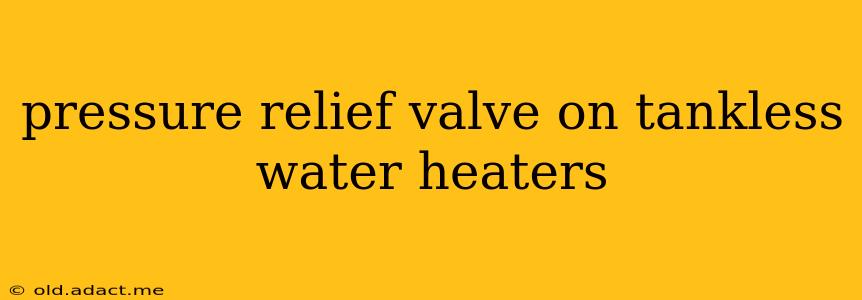Tankless water heaters, while offering numerous benefits like endless hot water and energy efficiency, also require a crucial safety component: the pressure relief valve (PRV). This valve is essential for preventing dangerous pressure buildup within the system, protecting your home and family from potential hazards. This comprehensive guide will explore the vital role of the PRV in tankless water heaters, addressing common questions and concerns.
What is a Pressure Relief Valve (PRV) and How Does it Work?
A pressure relief valve is a safety device designed to automatically release excess pressure from a closed system, such as a tankless water heater. Inside the valve is a spring-loaded mechanism. When the pressure inside the water heater exceeds a predetermined limit (typically 150 PSI), the spring is overcome, and the valve opens, releasing hot water to safely relieve the pressure. This prevents the tankless unit from rupturing or exploding due to excessive pressure. Think of it as a safety valve preventing a potentially dangerous situation.
Why is a Pressure Relief Valve Necessary on a Tankless Water Heater?
Several factors can lead to pressure buildup within a tankless water heater, making the PRV indispensable:
- Thermal Expansion: As water heats, it expands. In a closed system, this expansion can significantly increase pressure.
- Restricted Water Flow: If the water flow is restricted (e.g., by a clogged pipe), pressure can build up quickly.
- System Malfunctions: Internal component failures within the tankless water heater can also contribute to excessive pressure.
- Water Supply Pressure: An unusually high water supply pressure from the main line can also add to the pressure in the system.
How Often Should I Test My Tankless Water Heater's Pressure Relief Valve?
While the frequency isn't strictly regulated like some other appliances, it's recommended to test your tankless water heater's PRV at least annually. Testing ensures the valve functions correctly and will release pressure when needed. To test it, simply locate the valve (usually on the side or top of the unit), and carefully pull the lever. Hot water should flow briefly, indicating the valve is operational. If no water flows, the valve may be malfunctioning and needs professional attention. Never attempt major repairs yourself; always call a qualified plumber.
What Happens If My Pressure Relief Valve Fails?
A malfunctioning PRV poses a significant safety risk. If the valve fails to release excess pressure, the tankless water heater could rupture, leading to:
- Water damage: Extensive flooding and property damage can result from a ruptured unit.
- Scalding injuries: The hot water released from a ruptured tankless water heater can cause serious burns.
- Damage to the Water Heater: The pressure can damage internal components and necessitate costly repairs or replacement.
How Can I Prevent Pressure Buildup in My Tankless Water Heater?
While the PRV is the primary safety measure, several preventative steps can minimize the risk of excessive pressure:
- Regular Maintenance: Schedule annual maintenance by a qualified technician to inspect and clean the unit, ensuring proper functionality.
- Check Water Pressure: Ensure your home's water pressure isn't excessively high. A pressure regulator can be installed to reduce it if needed.
- Address Restricted Flow: Deal with any issues that might restrict water flow promptly, such as a clogged pipe or faulty valve.
Can I Replace the Pressure Relief Valve Myself?
Replacing a pressure relief valve is best left to qualified plumbers. While the process may seem simple, incorrect installation can compromise safety and void warranties. Furthermore, working with hot water systems requires expertise and safety precautions to avoid accidents.
What Size Pressure Relief Valve Do I Need for My Tankless Water Heater?
The appropriate size of the PRV is usually determined by the manufacturer’s specifications for your specific tankless water heater model. Consult your owner's manual for the correct size and never try to install a valve larger than recommended.
This guide provides comprehensive information about the crucial role of the pressure relief valve in tankless water heaters. Regular testing and maintenance, combined with professional installation, are essential to ensure the safe and efficient operation of your tankless water heating system. Remember that safety should always be the top priority.
